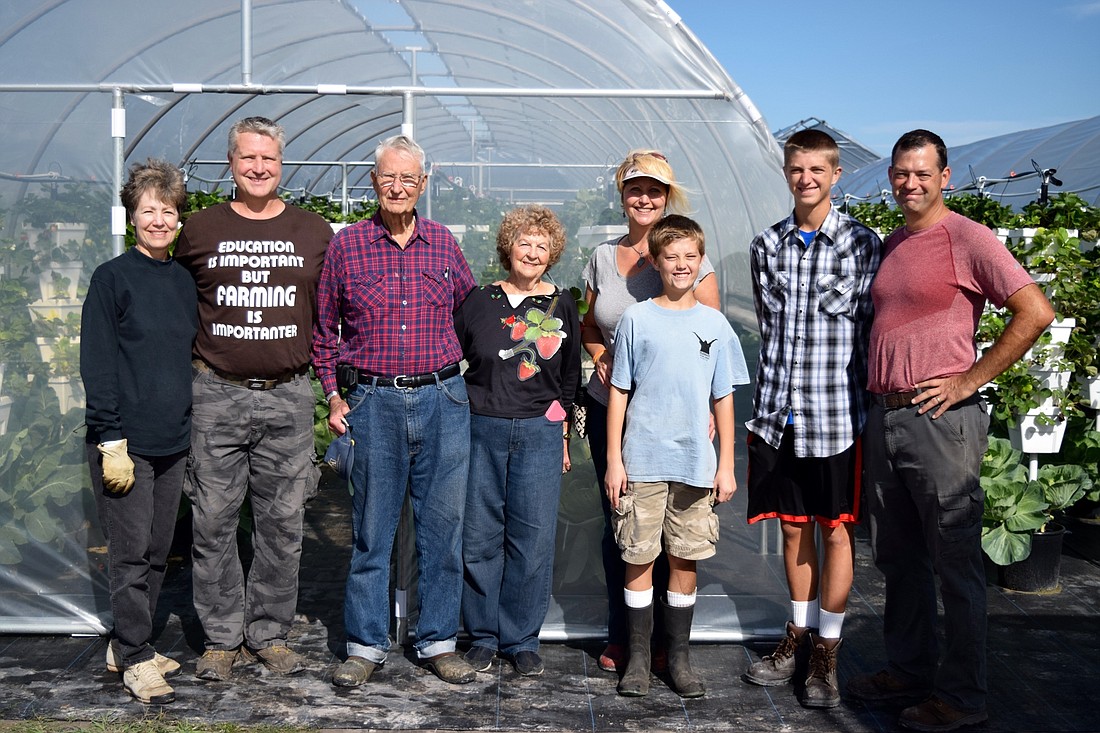- April 19, 2024
-
-
Loading

Loading

WINTER GARDEN At the Bekemeyer Family Farm, a now-defunct 1920s single-stroke gas engine sits covered in a dirt field. An old white house toward the front of the property was where family patriarch George Bekemeyer and his siblings were raised — now the house is uninhabited. And in the midst of it all are rows upon rows of towers stacked with various plants, some in greenhouses.
“I grew up on the farm, and I knew how much work it was, so I became a printer,” George joked. “I went to Lakeview and worked out here with Dad and at the Winter Garden press shop. I used to have to cut spinach for him to take to the farmer’s market. And he’d get up and go there at 4:30 in the morning with the stuff he harvested the day before. We remember a couple of nights where we’d stay up till 10:30 or 11 p.m. bundling broccoli, so it was a never-ending thing.”
“It’s good to see that it’s going to be kept into a farm. In four more years, (the farm) will have been here for 100 years. … God’s been good to us.”
— George Bekemeyer
The 20-acre farm started with a small orange grove around the house, but the rest of it was pine trees and palmettos until John Bekemeyer’s grandfather planted an orange grove there when he moved to Winter Garden in 1920.
“My dad said he could remember my grandfather with the mule, clearing it and planting it and then making the back part the garden,” John said. “As I grew up, I just remember it being all grove and garden. … The back five acres were, for a long time, his field crops, where he would do truck farming.”
But that changed through the years and culminated in March 2015, when the orange grove was decimated by a citrus greening disease, killing all of the trees. The family knew it had to do something to repurpose and replenish the land.
“We saw that the trees were dying, so I told John that we need to keep our agricultural assessment or they’d tax you right off your land,” George said. “I thought he’d come up with hay or pine trees and just put them in the ground and watch them grow. But he came up with this.”
HYDROPONICS
Since then, an acre so far has been converted into a U-pick hydroponics farm. The family uses a system called Verti-Gro hydroponics, invented in Summerfield by Tim Carpenter and patented in 1996. Hydroponics, or gardening without soil, uses water and mineral nutrient solutions such as coconut coir fiber, perlite or vermiculite instead of soil. Verti-Gro’s system consists of “high towers” with vertically stacked polystyrene-like pots, which can each hold four or more plants. In this way, it is possible to grow anywhere between 12,000 to 120,000 plants per acre via the system, the same one that has been used at Epcot’s land pavilion.
Overhead pipes and tubes are used to automatically irrigate the towers with water and other nutrients — such as liquid fertilizer and calcium — which drip down from the top of the towers to the bottom pot.
“Everything is on timers, so you adjust the length of the time that it runs so that the bottom pot just barely drips water,” John said. “Various things can be planted in the bottom pots to let them use the extra water. Your primary products are in the upper stacks, and whatever suits well with the chemistry of the plants you’re fertilizing above you can plant below and let them use the excess water.”
Aside from the system’s ability to save space, the Verti-Gro website lists benefits ranging from less water and fertilizer usage to better utilization of space, no weeds and an insulated root system.
And save space it does. In just under of an acre of land, the Bekemeyers have been able to grow a wide range of produce, from strawberries, tomatoes and peppers to beets, broccoli and lettuce.
“This is our first year, and we’ve only been open since the week after Thanksgiving,” John said. “There’s more to come. We just have to get our system down, get our rotation in and get our hours of operation more firm.”
His advice for anyone interested in learning about hydroponics is to start early and do extensive research.
“Verti-Gro has a wealth of literature online to help,” he said. “Compared to ground gardening, though, it is much easier to maintain and care for. Once we catch up with ourselves, we hope to be a (Verti-Gro) home kit authorized distributor.”
The rest of the land has been contoured with various beds, ditches and swales, which helps combat drainage issues by bringing runoff back to a pond, a process called tailwater recovery, which prevents it from running into Winter Garden’s water systems. Soon there will be an acre of blueberries with a few rows of blackberries and an acre of peaches, and the rest of the 14 acres will be citrus once again, John said.
“It’s good to have them all working together,” George said. “It’s good to see that it’s going to be kept into a farm. In four more years, (the farm) will have been here for 100 years. … God’s been good to us.”
Contact Danielle Hendrix at [email protected].